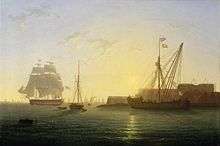Sheerness Dockyard
Sheerness Dockyard was a naval dockyard at Sheerness in Kent.
History

The Secretary of the Admiralty, Samuel Pepys, subsequently ordered the construction of a Sheerness Dockyard as an extension to that at Chatham,[1] where naval ships would be maintained and repaired. Low quality housing and the poor water supply near the dockyard led to a lack of workers and caused construction delays, and the first dry-dock was not completed until 1708. Using materials they were allowed to take from the yard, dockyard construction workers built the first houses in Sheerness. The grey-blue naval paint they used on the exteriors led to their homes becoming known as the Blue Houses. This was eventually corrupted to Blue Town, the modern name of the north-west area of Sheerness.[2]

Following the Napoleonic Wars, an opportunity was taken to rebuild the Dockyard. The site was leveled in 1815, and over the next 15 years the new Dockyard was laid out, according to meticulous plans drawn up by John Rennie. A full-scale model created at the time, which still exists, shows how much of the original remains. The principal architects were Edward Holl and his successor George Taylor who was already an established architect with a practice in London and had been responsible for some of London's most fashionable squares. In all the project cost £2,586,083 and was completed by 1830, providing fine terraced houses for naval officers. Sheerness was unusual among Dockyards in the unity and clarity of its design, having been built in one phase of construction, of a single architectural style according to a unified plan (rather than developing piecemeal over time).[3]
In the early 1820s a fire destroyed many buildings at the dockyard, including all the Blue Houses. New houses and a major redevelopment of the dockyard followed. On 5 September 1823, the rebuilt dockyard was formally opened by the Duke of Clarence (later William IV). A high brick wall and a moat were constructed around the yard to serve as a defence measure and remained in place until the end of the 19th century. As the settlement expanded eastwards, away from the dockyard and the Blue Houses, the wider area became known as Sheerness,[2] taking its new name from the brightness or clearness of the water at the mouth of the River Medway.[4] Completed in 1860 and still standing today, the Sheerness Boat Store was the world's first multi-storey building with a rigid metal frame.[2]
From the completion of the dockyard until 1960 Sheerness was one of the bases of the Nore Command of the Royal Navy, which was responsible for protecting British waters in the North Sea. The command was named after the Nore sandbank in the Thames Estuary, about 3 miles (5 km) east of Sheerness.[5] In 1797, discontented sailors in the Royal Navy mutinied just off the coast of Sheerness.[6]
In March 1960 the Royal Navy ceased operating the Sheerness dockyard and the Medway Port Authority took over the site for commercial use. The dockyard closure led to thousands of job losses, and most of the nearby houses and shops in the Bluetown area were eventually abandoned and demolished.[1]
References
- 1 2 "1958: Historic Sheerness docks to close". BBC. 20 February 1958. Retrieved 29 April 2007.
- 1 2 3 "History". Sheppey Access. Retrieved 29 April 2007.
- ↑ Sheerness Dockyard's entry on the Buildings at Risk register.
- ↑ "Sheerness". MaritimeHeritageTrail.co.uk. Archived from the original on 30 August 2007. Retrieved 29 April 2007.
- ↑ "The Nore". The Columbia Encyclopedia. 2006. Retrieved 29 April 2007.
- ↑ "Mutiny". The Columbia Encyclopedia. 2006. Retrieved 29 April 2007.
Coordinates: 51°26′31″N 0°45′11″E / 51.442°N 0.753°E